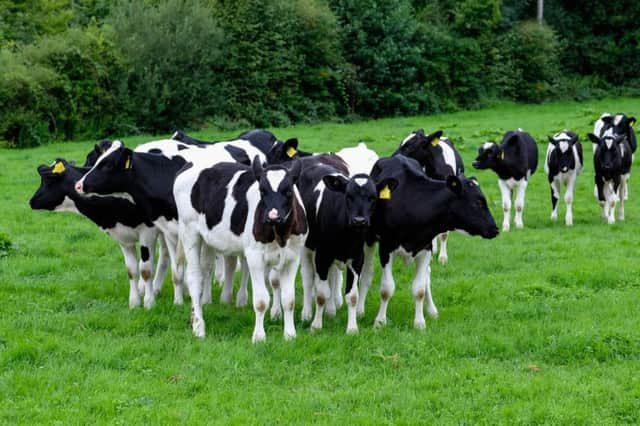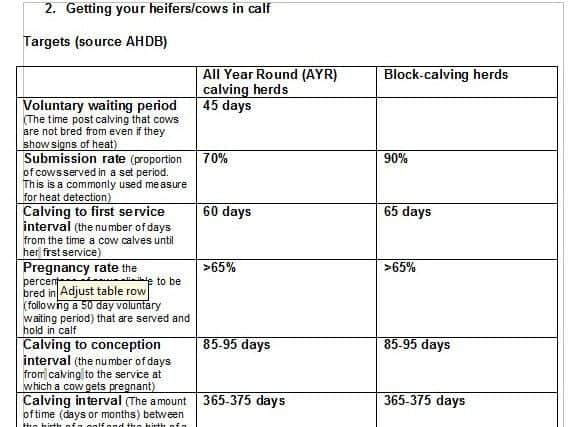Realising your herd’s potential - breeding goals


Rearing heifers requires significant upfront investment; it costs £2.31 a day or £1,819.01 on average to rear a dairy heifer replacement. Payback takes at least until the middle of her second lactation.
By managing a heifer well and predicting her ability earlier, you can control your expenditure by adapting breeding approach based on heifer quality.
Managing heifers
Advertisement
Advertisement


A lot of emphasis is put on getting cows to calve down at 24 months or less and for good reason. The sooner a heifer calves, the sooner you can start realising a return on your investment.
There’s substantial evidence to show heifers calving later are less productive and are more likely to leave the herd in their first lactation; this is before they have even started generating any profit for the farm.
Those that do go on to have further lactations tend to have relatively poor fertility with longer calving intervals.
As a result, the focus needs to be on getting heifers pregnant at 14-15 months of age. Puberty in cattle is mainly dependant on weight not age. Puberty starts when heifers are about 40% of their mature bodyweight with a target of 55% by the time they are mated. This means heifer growth is paramount, particularly from weaning to puberty.
Advertisement
Advertisement
To achieve rapid growth without animals becoming too fat requires careful heifer management from birth to first calving and beyond.
To achieve a target growth rate of 0.7kgs a day calves must receive enough colostrum at birth, be gradually weaned, housed in adequate accommodation with good ventilation, and receive appropriate vaccinations.
1. Selecting replacements
The first thing you need to do is decide how many replacements you need and which animals to keep.
Some farmers can be ‘heifer hoarders’, keeping more than necessary and putting them all in calf to sexed semen which is costly.
Advertisement
Advertisement
Therefore, rather than applying a blanket strategy for using sexed semen you can identify the top 1/3rd of heifers, and use sexed semen on them. You can also target your top first and second lactation cows.
Genomic testing using a simple test like CLARIFIDE® highlights the genetic merit of each animal allowing you to select with about 70% accuracy which animals to breed from depending on their selection criteria.
Genomic testing gives a prediction on;
- Health and Fitness
- Production and Management
- Type and Composites
- Milk Protein Components
- Parentage and Inbreeding
Genomics is much more accurate than using Parent Averages which have an accuracy of less than 30%.
It is simple to do, requiring just a hair or small tissue sample to be sent off for testing at a lab.
Advertisement
Advertisement
Your farm’s overall breeding strategy will dictate what your selection criteria will be and how much emphasis you put on it.
If a heifer meets your selection criteria but has some weaker traits, you can use a bull on her that will help improve those traits.
Once you have selected which heifers to breed from and you know they are at the right size for breeding, then it’s about getting them in calf. If the above targets are not being met then action is needed.
Fertility can only be improved if records are made and figures compared against the targets.
Advertisement
Advertisement
Your vet should ideally be involved in post-calving checks to identify any problems post-calving, which could have a knock-on effect on cows’ cycling. Your nutritionist can also ensure any dietary issues are resolved a couple of weeks before the start of service.
Technology is available to help identify nutritional and health problems before they become visually apparent.
For example, SMARTBOW® can tell if an animal is eating, resting, on heat or ruminating as well as their real-time location in a shed. The earlier you can identify problems the earlier they can be rectified.
Likewise, detecting accurately when a cow is on heat allows you to optimise insemination results.
Advertisement
Advertisement
A whole host of issues can limit fertility. Five of the most important factors affecting fertility include:
1. Failure to detect cows in heat.
2. Nutrition: Is their body condition at the ideal 2.5-3?
3. Disease. Have they received appropriate vaccinations? Diseases including Bovine Viral Diarrhoea can affect fertility. Vaccinating or eradicating these diseases from your herd will help.
4. Heifer rearing. Late calving heifers or heifers that are underweight will impact their ability to get in calf or get back in calf.
5. Semen handling. If you are artificial inseminating cows and heifers yourself, you need to make sure the semen is handled correctly. This includes correct storage, handling and thawing at the right temperature.
Advertisement
Advertisement
The options for getting cows in calf ranges from natural service through to artificial insemination (AI) and more recent technology such as IVF.
Your choice will depend on factors relevant to your farm such as accuracy of heat detection and speed of genetic gain.
For block calving herds, working with your vet and nutritionist to achieve a tight calving block is important.
Farmers operating a block calving system wishing to tighten up calving intervals can benefit from oestrus synchronisation programmes. They have been found to greatly improve pregnancy rates and heat detection.